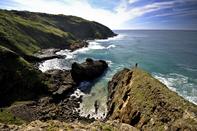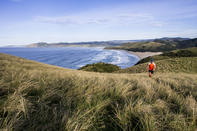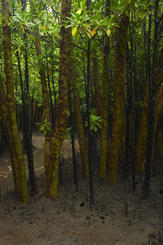Coastal Nature
Just south of Port St Johns, Third Beach, lies Silaka Nature Reserve, a reserve that conserves a near pristine patch of Eastern Cape coastal forest. It’s bisected by the Gxwaleni River, which attracts considerable bird life; while just offshore, Bird Rock is a haven for white-fronted cormorants.

Mkhambati Nature Reserve lies on a breathtaking stretch of Pondoland coast north of Port St Johns. The roads can be a bit worse for wear, but the landscape makes up for it, with waterfalls plunging into the sea, forested ravines and grasslands teeming with game that includes eland, kudu, red hartebeest and zebra.
Coastal Forest

The northern section of the Wild Coast is really the part that justifies the moniker, with soaring dolerite cliffs, deep forested clefts and secret coves you'll discover only if you are a fisherman or a hiker, or if you fly over the place at low altitude. There are few roads to the coast, and none to the spot where the Mhlankulu River plummets straight over the cliffs into the pounding sea at Waterfall Bluff, about 20 km north of Mbotyi and the same distance south of Lupatana Bay.
The vegetation of the entire Wild Coast is classified as coastal forest, although long-term habitation by farmers has led to the decimation of the woodlands, and most of the resulting grassland is kept in a cropped, park-like state through continuous burning and grazing. Small relict forest patches remain, the actual species composition varying considerably according to soil type.
The three major forest communities are eastern coast-belt forest, dune forest and mangroves. The largest forests to be seen on this hike will be those covering Mount Sullivan, which flanks the mighty Mzimvubu River. All others are small and under threat of extinction.
Most of the wild animals and birds associated with the Wild Coast are confined to the larger forests, such as those at Mbotyi, Port St Johns, Cwebe and Dwesa. Small antelope, monkeys, bush pigs, small cats and tree dassies are the most common of the forest animals, while birds include Knysna lourie, woodhoopoe, southern boubou (shrike) and sombre bulbul.
On the forest edges you are more likely to see trumpeter hornbills, fork tailed drongos, red necked francolin, black eyed bulbuls, brown headed kingfishers, spotted prinias, streaky headed canaries and, most showy of all, paradise flycatchers.
Near rivers there are fish eagles and various kingfishers, dikkops and other waders, while along the sandy beaches black oystercatchers, cormorants, common terns and small waders are plentiful.
Mangrove Tree

There are three mangrove tree species found in Southern Africa, and Port St John is one of only three places where white, black and red species are found together. The trees of these odd forests root themselves into the mud of the river Estuary intertidal area, colonising new ground as they proliferate. Unfortunately, in recent times southern Africa's mangrove communities have been dwindling, while those at Mngazana River are under threat of giving way to a harbour development; currently ski boats berth on jetties within the forest.
Patience is needed to appreciate the complex web of life that occurs within the mangroves: tiny snails, colourful fiddler mud crabs and giant river crabs, mangrove kingfishers and sandpipers, mudskippers and the many fish found in tidal estuaries.
The mangrove trees are totally dependent on tidal flow and silt, with bizarre-looking buttressed or aerial root systems adapted to their fluctuating environment. No other plants can tolerate the extremes of saline and fresh water, flood and drought of the constant tidal wash.